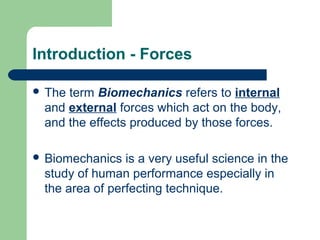More Related Content
What's hot
What's hot (20)
Musculoskeletal system:Anatomy of the Lumbar region 

Musculoskeletal system:Anatomy of the Lumbar region
Viewers also liked
Viewers also liked (12)
Forces
- 1. Introduction - Forces The term Biomechanics refers to internal and external forces which act on the body, and the effects produced by those forces. Biomechanics is a very useful science in the study of human performance especially in the area of perfecting technique.
- 2. Forces Internal Forces – the contraction of muscles to move bones and produce movement E.g. A bicep curl where the bicep contracts to move the forearm (radius and ulna)
- 3. Forces External Forces – are forces which act outside the body E.g. – contact with the ground, wind, air and water resistance.
